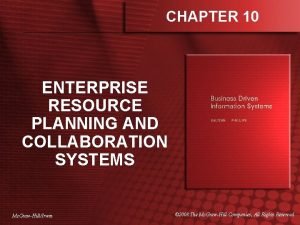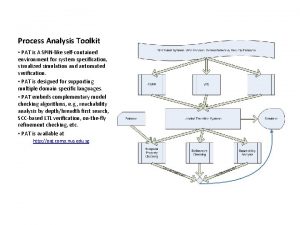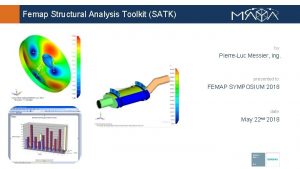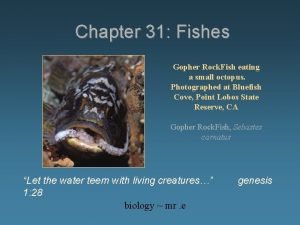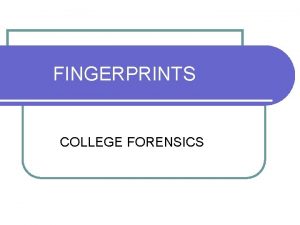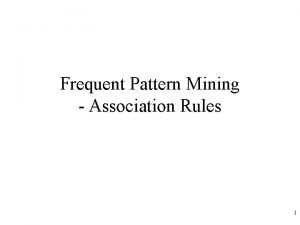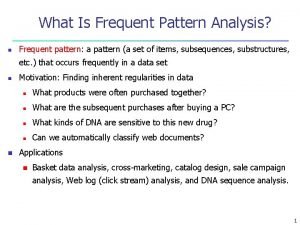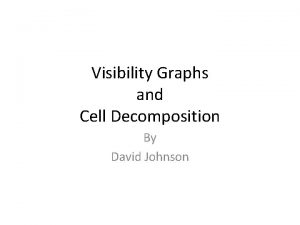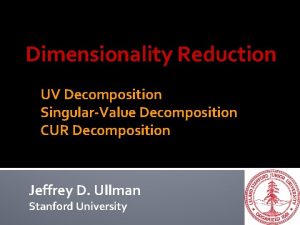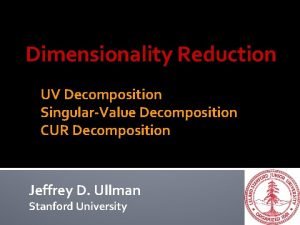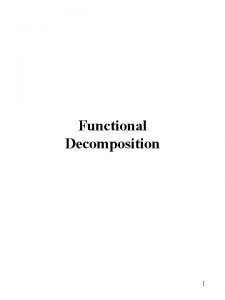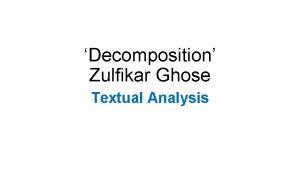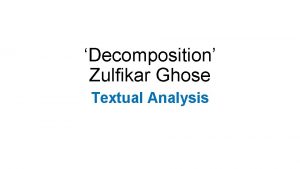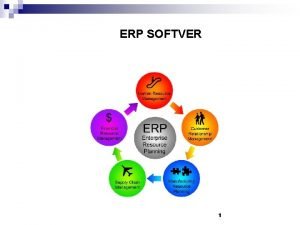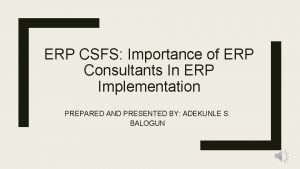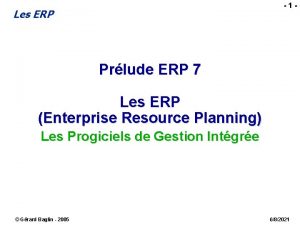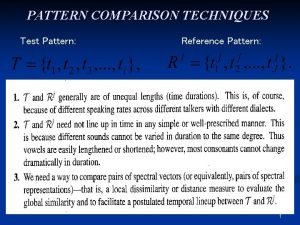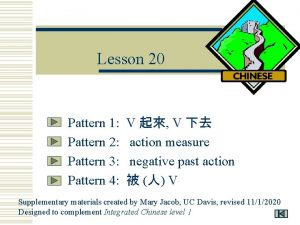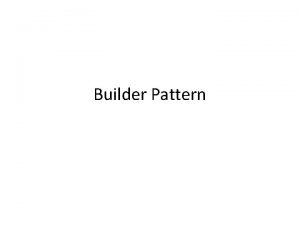NEMO ERP Analysis Toolkit ERP Pattern Decomposition An






























- Slides: 30

NEMO ERP Analysis Toolkit ERP Pattern Decomposition An Overview

NEMO processing pipeline 2/11/11 NEMO NIH Annual All-Hands Meeting 2

NEMO Data Analysis 2/11/11 NEMO NIH Annual All-Hands Meeting 3

NEMO Information Processing Pipeline ERP Pattern Extraction, Identification and Labeling v Obtain ERP data sets with compatible functional constraints – NEMO consortium data v Decompose / segment ERP data into discrete spatio-temporal patterns – ERP Pattern Decomposition / ERP Pattern Segmentation v Mark-up patterns with their spatial, temporal & functional characteristics – ERP Metric Extraction v Meta-Analysis v Extracted ERP pattern labeling v Extracted ERP pattern clustering v Protocol incorporates and integrates: v ERP pattern extraction v ERP metric extraction/RDF generation v NEMO Data Base (NEMO Portal / NEMO FTP Server) v NEMO Knowledge Base (NEMO Ontology/Query Engine)

ERP Pattern Decomposition Tool MATLAB and Directory Configuration v Get Latest Toolkit Version (NEMO Wiki : Screencasts : Versions ) – Update your local (working) copy of the NEMO Sourceforge Repository v Configure MATLAB (NEMO Wiki : Screencasts : NEMO ERP Analysis Toolkit I) – MATLAB R 2010 a / R 2010 b, Optimization and Statistics Toolboxes – Add to the MATLAB path, with subfolders: § NEMO_ERP_Dataset_Import / NEMO_ERP_Dataset_Information § NEMO_ERP_Metric_Extraction / NEMO_ERP_Pattern_Decomposition / NEMO_ERP_Pattern_Segmentation v Configure Experiment Folder (NEMO Wiki : Screencasts : NEMO ERP Analysis Toolkit I & II) – Create an experiment-specific parent folder containing Data, Metric Extraction, Pattern Decomposition and Pattern Segmentation subfolders – Copy the metric extraction, decomposition and segmentation script templates from your NEMO Sourceforge Repository working copy to their respective script subfolders – Add the experiment-specific parent folder, with its subfolders, to the MATLAB path

ERP Pattern Decomposition Tool Metascript Configuration – Step 1 of 7: Data Parameters v File_Name v Electrode_Montage_ID v Cell_Index v Factor_Index v ERP_Onset_Latency v ERP_Offset_Latency v ERP_Baseline_Latency

ERP Pattern Decomposition Tool Metascript Configuration – Step 1 of 7: Data Parameters v File_Name – Name of an EGI segmented simple binary file, as a single-quoted string § Example: ‘Sim. Erp. Data. raw’ § At present, Metric Extraction only accepts factor files from the Pattern Decomposition tool v Electrode_Montage_ID – Name of an EGI/Biosemi electrode montage file, as a single-quoted string § Valid montage strings: ‘GSN-128’, ‘GSN-256’, ‘HCGSN-128’, ‘HCGSN-256’, ‘Biosemi-64+5 exg’, ‘Biosemi-64 -sans. NZ_LPA_RPA’ § The NEMO ERP Analysis Toolkit will require EEGLAB channel location file (. ced) format for all proprietary, user-specified, montages v Cell_Index – Indices of cells / conditions to import, as a MATLAB vector § Indices correspond to the ordering of cells in the data file § See Metric_obj. Dataset. Metadata. Src. File. Info. Cellcode for the ordered list of conditions v Factor_Index – Indices of PCA factors to import, as a MATLAB vector § Indices correspond to the ordering of factors in the data file

ERP Pattern Decomposition Tool Metascript Configuration – Step 1 of 7: Data Parameters v ERP_Onset_Latency – Time, in milliseconds, of the first ERP sample point to import, as a MATLAB scalar § 0 ms = stimulus onset § Positive values specify post-stimulus time points, negative values pre-stimulus time points § All latencies must be in integer multiples of the sampling interval (for example, +’ve / -’ve multiples of 4 ms @ 250 Hz) v ERP_Offset_Latency – Time, in milliseconds, of the last ERP sample point to import, as a MATLAB scalar § 0 ms = stimulus onset § Positive values specify post-stimulus time points, and must be greater than the ERP_Onset_Latency § ERP_Offset_Latency must not exceed the final data sample point (for example, a 1000 ms ERP with a 200 ms baseline: maximum 800 ms ERP_Offset_Latency) v ERP_Baseline_Latency – Time, in negative milliseconds, of the pre-stimulus ERP sample points to exclude from import, as a MATLAB scalar § ERP_Baseline_Latency = 0 no baseline § To import pre-stimulus sample points, specify ERP_Baseline_Latency < ERP_Onset_Latency < 0 § All latencies must be within the data range (for example, a 1000 ms ERP with a 200 ms baseline: ERP_Baseline_Latency = -200 ms, ERP_Onset_Latency = 0 ms and ERP_Offset_Latency = 800 ms imports the 800 ms post-stimulus interval, including stimulus onset)

ERP Pattern Decomposition Tool Metascript Configuration – Step 2 of 7: Experiment Parameters (Required) v Lab_ID v Experiment_ID v Session_ID v Subject_Group_ID v Subject_ID v Experiment_Info

ERP Pattern Decomposition Tool Metascript Configuration – Step 2 of 7: Experiment Parameters (Required) v Lab_ID – Laboratory identification label, as a single-quoted string § Example: ‘My Simulated Lab’ v Experiment_ID – Experiment identification label, as a single-quoted string § Example: ‘My Simulated Experiment’ v Session_ID – Session identification label, as a single-quoted string § Example: ‘My Simulated Session’ v Subject_Group_ID – Subject group identification label, as a single-quoted string § Example: ‘My Simulated Subject Group’ v Subject_ID – Subject identification label, as a single-quoted string § Example: ‘My Simulated Subject # 1’ v Experiment_Info – Experiment note, as a single-quoted string § Example: ‘t. PCA with Infomax rotation’

ERP Pattern Decomposition Tool Metascript Configuration – Step 3 of 7: Experiment Parameters (Optional) v Event_Type_Label v Stimulus_Modality_Label v Cell_Label_Descriptor

ERP Pattern Decomposition Tool Metascript Configuration – Step 3 of 7: Experiment Parameters (Optional) v Event_Type_Label – MATLAB cell array of cell/condition event type labels § One label per cell/condition, as a single-quoted string § Example: {‘Sim. Event. Type 1’, ‘Sim. Event. Type 2’, ‘Sim. Event. Type 3’} v Stimulus_Type_Label – MATLAB cell array of cell/condition stimulus type labels § One label per cell/condition, as a single-quoted string § Example: {‘Sim. Stimulus. Type 1’, ‘Sim. Stimulus. Type 2’, ‘Sim. Stimulus. Type 3’} v Stimulus_Modality_Label – MATLAB cell array of cell/condition stimulus modality labels § One label per cell/condition, as a single-quoted string § Example: {‘Sim. Stimulus. Modality 1’, ‘Sim. Stimulus. Modality 2’, ‘Sim. Stimulus. Modality 3’} v Cell_Label_Descriptor – MATLAB cell array of cell/condition description labels § One label per cell/condition, as a single-quoted string § Optional Labels: E-prime assigned cell codes imported from input data file § Example: {‘Sim. Condition. Description 1’, ‘Sim. Condition. Description 2’, ‘Sim. Condition. Description 3’}

ERP Pattern Decomposition Tool Metascript Configuration – Step 4 of 7: Stage 1 Component Decomposition Parameters Stage 1 t. PCA v PCAmode v MAT_TYPE v ROTATION v LOADING v NUM_FAC v SORTOPT v GAVE

ERP Pattern Decomposition Tool Metascript Configuration – Step 4 of 7: Stage 1 Component Decomposition Parameters v PCAmode – Specifies the PCA mode, as a single-quoted string § ‘temp’: Temporal PCA, in which time points are variables § ‘spat’: Spatial PCA, in which channel voltages are variables v MAT_TYPE – Specifies the PCA eigenvector/relationship matrix, as a single-quoted string § ‘COV’: Covariance matrix (mean correction) § ‘COR’: Correlation matrix (mean + variance correction) § ‘SCP’: Sum of squares cross product (no mean/variance correction) v ROTATION – Specifies the PCA factor rotation type, as a single-quoted string § ‘IMAX’: Infomax - ”Statistically Independent” factor loadings via high-order statistics § ‘VMAX’: Varimax - Maximal variance factor loadings subject to orthogonality constraint § ‘PMAX’: Promax - Relaxes factor orthogonality constraint of relationship matrix eigenvectors Promax rotation is automatically applied subsequent to Varimax rotation when ROTATION = ‘VMAX’

ERP Pattern Decomposition Tool Metascript Configuration – Step 4 of 7: Stage 1 Component Decomposition Parameters v LOADING – Specifies factor loading type, the rotated factor loading scaling transform, as a single-quoted string § ‘N’: None § ‘K’: Kaiser § ‘C’: Covariance § ‘W’: Cureton-Mulaik v NUM_FAC – Specifies the number of PCA factors to rotate, as a MATLAB scalar § For s. PCA: 1. LE. NUM_FAC. LE. number of electrode channels § For t. PCA: 1. LE. NUM_FAC. LE. number of imported ERP time points v SORTOPT – Specifies the ordering (sort) of post-rotation PCA factors, as a single quoted string § ‘Pre. Rot’: Sort in order of decreasing pre-rotation (eigenvector) factor variance § ‘Fac. Var’: Sort in order of decreasing post-rotation factor variance, via Fac. Var parameter v GAVE – Optionally perform analysis on grand average data § ‘N’: Perform analysis on subject average data only § ‘Y’: Perform analysis on grand average data; convert factor scores to subject average form for export

ERP Pattern Decomposition Tool Metascript Configuration – Step 4 of 7: Stage 2 Component Decomposition Parameters Stage 1 t. PCA _st spatio-temporal or stage 2 PCA parameters v MAT_TYPE_st v ROTATION_st v LOADING_st v NUM_FAC_st v SORTOPT_st

ERP Pattern Decomposition Tool Metascript Configuration – Step 4 of 7: Stage 2 Component Decomposition Parameters v PCAmode – Specifies the PCA mode, as a single-quoted string § ‘temp’: Temporal PCA, in which time points are variables § ‘spat’: Spatial PCA, in which channel voltages are variables Stage 1 t. PCA Stage 2 s. PCA Stage 1 s. PCA Stage 2 t. PCA v MAT_TYPE_st – Specifies the PCA eigenvector/relationship matrix, as a single-quoted string § ‘COV’: Covariance matrix (mean correction) § ‘COR’: Correlation matrix (mean + variance correction) § ‘SCP’: Sum of squares cross product (no mean/variance correction) v ROTATION_st – Specifies the PCA factor rotation type, as a single-quoted string § ‘IMAX’: Infomax - ”Statistically Independent” factor loadings via high-order statistics § ‘VMAX’: Varimax - Maximal variance factor loadings subject to orthogonality constraint § ‘PMAX’: Promax - Relaxes factor orthogonality constraint of relationship matrix eigenvectors Promax rotation is automatically applied subsequent to Varimax rotation when ROTATION = ‘VMAX’

ERP Pattern Decomposition Tool Metascript Configuration – Step 4 of 7: Stage 2 Component Decomposition Parameters v LOADING_st – Specifies factor loading type, the rotated factor loading scaling transform, as a single-quoted string § ‘N’: None § ‘K’: Kaiser § ‘C’: Covariance § ‘W’: Cureton-Mulaik v NUM_FAC_st – Specifies the number of PCA factors to rotate, as a MATLAB scalar § 1. LE. NUM_FAC_st. LE. NUM_FAC (Number of stage 1 factors to rotate) v SORTOPT_st – Specifies the ordering (sort) of post-rotation PCA factors, as a single quoted string § ‘Pre. Rot’: Sort in order of decreasing pre-rotation (eigenvector) factor variance § ‘Fac. Var’: Sort in order of decreasing post-rotation factor variance, via Fac. Var parameter v GAVE – Optionally perform analysis on grand average data Specified in Stage 1 § ‘N’: Perform analysis on subject average data only § ‘Y’: Perform analysis on grand average data; convert factor scores to subject average form for export

ERP Pattern Decomposition Tool Metascript Configuration – Step 5 of 7: Export to EGI Simple Binary Parameters Stage 1 v Num_Fac_Export Stage 2 v Num_Fac_Export_st v Cell_IO_Rule v Output_File_Type v Grand_Avg_Add v Exclude_Channel

ERP Pattern Decomposition Tool Metascript Configuration – Step 5 of 7: Export to EGI Simple Binary Parameters v Num_Fac_Export / Num_Fac_Export_st – Specifies the number of stage 1 / stage 2 PCA factors to export, as a MATLAB scalar § 1. LE. Num_Fac_Export. LE. NUM_FAC (# of stage 1 PCA factors to rotate) § 1. LE. Num_Fac_Export_st. LE. NUM_FAC_st (# of stage 2 PCA factors to rotate) v Cell_IO_Rule – Specifies the input cell to output cell rule, as a 2 D MATLAB array § Output cell x input cell logical indexing matrix § Type <My. Pattern. Decomposition. Object>. Help. Topic(‘PCAto. Egi. Sbin’) For Detail v Output_File_Type – Specifies the output PCA factor file type, as a single quoted string § ‘G’: Grand average factor file (Average across subject factors for each cell type | 1 file) § ‘S’: Subject average factor file (Subject-specific factors for each cell type | 1 file per subject) v Grand_Avg_Add – Specifies option to add grand average to factor reconstructions § ‘N’: Do not add grand average to factor reconstructions § ‘Y’: Add grand average to factor reconstructions v Exclude_Channel – List of peri-ocular or midline channels to omit in ANOVA (N/A = []), as a MATLAB vector

ERP Pattern Decomposition Tool Metascript Configuration – Step 6 of 7: Class Instantiation I Instantiate EGI reader class object Initialize object parameters Import metadata Import signal (ERP) data

ERP Pattern Decomposition Tool Metascript Configuration – Step 6 of 7: Class Instantiation I (EP Toolkit) Instantiate EGI reader class object Initialize object parameters Import metadata and signal (ERP) data via EPToolkit’s ep_read. Data

ERP Pattern Decomposition Tool Metascript Configuration – Step 6 of 7: Class Instantiation II Instantiate Pattern Decomposition class object Initialize object parameters

ERP Pattern Decomposition Tool Metascript Configuration – Step 7 of 7: Class Invocation Call Compute. Two. Stage. PCA method: Two stage PCA decomposition Call One. Stage. PCAto. Egi. Sbin method: Export One stage PCA decomposition results Call Two. Stage. PCAto. Egi. Sbin method: Export Two stage PCA decomposition results Call Plot. Factor. Variance method: Plot unrotated factor scree and rotated factor variance

ERP Pattern Decomposition Tool Metascript Configuration – Step 7 of 7: Class Invocation (EP Toolkit) Call Compute. Two. Stage. PCA method: Two stage PCA decomposition Call One. Stage. PCAto. Egi. Sbin method: Export One stage PCA decomposition results Call Two. Stage. PCAto. Egi. Sbin method: Export Two stage PCA decomposition results Call Two. Stage. PCAto. EPwork. Cache method: Exports EPwork. Cache folder Call Plot. Factor. Variance method: Plot unrotated factor scree and rotated factor variance

ERP Pattern Decomposition Tool Plot Factor Variance GUI

ERP Pattern Decomposition Tool Folder Output for Sim. Erp. Data. raw v Pattern Decomposition output folder contents – RAW files • t. PCA: Input. Data. File_t. PCA_GAV/AVG. raw • s. PCA: Input. Data. File_s. PCA_GAV/AVG. raw • st. PCA/ts. PCA: Input. Data. File_st. PCA/ts. PCA_GAV/AVG. raw – Epwork Folder: EP Toolkit integration folder (if used EPT_read. Data) – Nemo. Erp. Pattern. Decompostion workspace object in MATLAB (. mat) format Input data file Time stamp

ERP Pattern Decomposition Tool Viewing Pattern Decomposition Class Properties in MATLAB v MATLAB Workspace view Nemo. Erp. Pattern. Decomposition object Egi. Raw. IO object Double click to open…

ERP Pattern Decomposition Tool Viewing Pattern Decomposition Class Properties in MATLAB v MATLAB Workspace view Keep on double clicking … v EPread. Data. Input: MATLAB structure of input parameters to ep_read. Data v Epdata: MATLAB structure of output data and metadata from ep_read. Data v EGIread. Data. Input: MATLAB structure of (optional) input parameters to EGI_read. Data and EGI_read. Meta. Data v Metadata: MATLAB structure of output metadata from EGI_read. Metadata v Data: MATLAB structure of output data from EGI_read. Data

ERP Pattern Decomposition Tool Viewing Pattern Decomposition Class Properties in MATLAB v MATLAB Workspace view Keep on double clicking … v EPdo. PCAInput: MATLAB structure of input parameters to ep_do. PCA v Factor. Results: MATLAB structure of output factor decomposition and metadata from ep_do. PCA v EPdo. PCAst. Input: MATLAB structure of input parameters to second PCA step (ep_do. PCAst) v Factor. Results. ST: MATLAB structure of output factor decomposition and metadata from second PCA step (ep_do. PCAst) v PCAto. Egi. Sbin: MATLAB structure of input parameters to One. Stage. PCAto. Egi. Sbin / Two. Stage. PCAto. Egi. Sbin
 Nemo toolkit
Nemo toolkit Scm, crm, and erp are all extended erp components.
Scm, crm, and erp are all extended erp components. Functional decomposition diagram
Functional decomposition diagram Requirements decomposition
Requirements decomposition Process analysis toolkit
Process analysis toolkit Structural analysis toolkit for nastran
Structural analysis toolkit for nastran Ultra posse nemo obligatur
Ultra posse nemo obligatur Plot structure exposition
Plot structure exposition Finding nemo crossing the threshold
Finding nemo crossing the threshold Sometime in december of 1891
Sometime in december of 1891 Symbolism in finding nemo
Symbolism in finding nemo Nemo 3a nutrition
Nemo 3a nutrition Nemo kidney disease
Nemo kidney disease Ad impossibilia nemo tenetur
Ad impossibilia nemo tenetur Finding nemo journey map
Finding nemo journey map Is nemo a round character
Is nemo a round character Shark chapter 31
Shark chapter 31 Nemo invex ii
Nemo invex ii Quae philosophia fuit facta philologia est
Quae philosophia fuit facta philologia est Nemo se sibi vindicat
Nemo se sibi vindicat Nemo moriturus praesumitur mentire
Nemo moriturus praesumitur mentire Spirit of nemo
Spirit of nemo Cadeia alimentar procurando nemo
Cadeia alimentar procurando nemo Schema nominativo terza declinazione
Schema nominativo terza declinazione Nemo latino
Nemo latino Nemo tracker
Nemo tracker Sub secondary classification formula
Sub secondary classification formula Patterns and pattern classes in digital image processing
Patterns and pattern classes in digital image processing Frequent pattern
Frequent pattern Frequent pattern
Frequent pattern Exact cell decomposition
Exact cell decomposition

